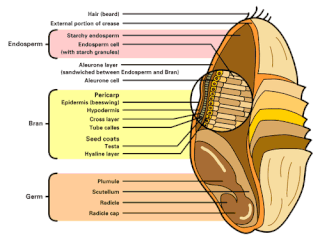Top Qs
Timeline
Chat
Perspective
Cereal germ
Reproductive part of a grass seed From Wikipedia, the free encyclopedia
Remove ads
The germ of a cereal grain is the part that develops into a plant;[1] it is the seed embryo.[2] Along with bran, germ is often a by-product of the milling[3] that produces refined grain products. Cereal grains and their components, such as wheat germ oil,[4] rice bran oil, and maize bran,[5] may be used as a source from which vegetable oil is extracted, or used directly as a food ingredient. The germ is retained as an integral part of whole-grain foods.[6] Non-whole grain methods of milling are intended to isolate the endosperm, which is ground into flour, with removal of both the husk (bran) and the germ. Removal of bran produces a flour with a white rather than a brown color and eliminates fiber. The germ is rich in polyunsaturated fats (which have a tendency to oxidize and become rancid on storage) and so germ removal improves the storage qualities of flour.[7]

Remove ads
Wheat germ
Wheat germ or wheatgerm is a concentrated source of several essential nutrients, including vitamin E, folate (folic acid), phosphorus, thiamin, zinc, and magnesium, as well as essential fatty acids and fatty alcohols.[10][11] It is a good source of fiber.[12] White bread is made using flour that has had the germ and bran removed.[13] Wheat germ can be added to protein shakes, casseroles, muffins, pancakes, cereals, yogurt, smoothies, cookies, and other goods.[14] Wheat germ can become rancid if not properly stored in a refrigerator or freezer[15] and away from sunlight.[16] Some manufacturers prevent rancidity by storing wheat germ in vacuum-sealed glass containers, or by placing an oxygen-absorbing sachet inside air-tight packaging.
Remove ads
Other uses
In molecular biology, wheat germ extract is used to carry out cell-free in vitro translation experiments: the plant embryo contains all the macromolecular components necessary for translating mRNA into proteins, but relatively low levels of its own mRNA.[17][18]
Wheat germ is also useful in biochemistry since it contains lectins that bind strongly to certain glycoproteins; therefore, it can be used to isolate such proteins.
Remove ads
See also
Notes
Wikiwand - on
Seamless Wikipedia browsing. On steroids.
Remove ads
